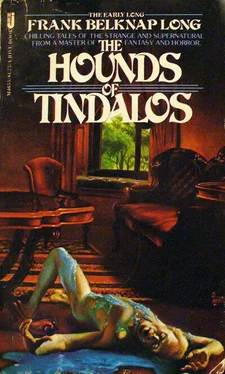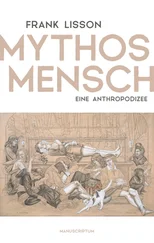Algernon nodded, and was silent for a moment. Then he stood up, laid his coffee cup on the windowsill and crossed to where Little was sitting. “We agreed,” he said, “that we wouldn’t discuss Chaugnar further until… well, until we were in a little calmer frame of mind than we were a few days ago. It was a wise decision, I think. But I’m now so certain that what we both witnessed was not an illusion that I must insist you return an honest answer to two questions. I shall not expect a comprehensive and wholly satisfying explanation, for I’m aware that you are not completely sure yourself as to the exact nature of Chaugnar. But you have at least formed an hypothesis, and there are a good many things you haven’t told me which I’ve earned the right to know.”
“What do you wish to know?” Little’s voice was constrained, reluctant.
“What destroyed the horror in the Pyrenees? Why were there no more massacres after — after that night?”
Little smiled wanly. “Have you forgotten the pools of black slime which were found on the melting snow a thousand feet above the village three days after we sent Chaugnar back?”
“You mean…”
Little nodded. “Chaugnar’s kin, undoubtedly. They accompanied Chaugnar back, but left like their master, a few remainders. Little round pools of putrescent slime — a superfluity of rottenness that somehow resisted the entropy- reversing action of the machine.”
“You mean that the machine sent entropy-reversing emanations half across the world?”
Little shook his head. “I mean simply that Chaugnar Faugn and its hideous brethren were joined together hyperdimensionally and that we destroyed them simultaneously. It is an axiom of virtually every speculative philosophy based on the newer physics and the concepts of non-Euclidean mathematics that we can’t perceive the real relations of objects in the external world, that since our senses permit us to view them merely three-dimensionally we can’t perceive the hyperdimensional links which unite them.
“If we could see the same objects — men, trees, chairs, houses — on a fourth-dimensional plane, for instance, we’d notice connections that are now wholly unsuspected by us. Your chair, to pick an example at random, may actually be joined to the window-ledge behind you or… to the Woolworth Building. Or you and I may be but infinitesimally tiny fragments of some gigantic monster occupying vast segments of space-time. You may be a mere excrescence on the monster’s back, and I a hair of its head — I speak metaphorically, of course, since in higher dimensions of space-time there can be nothing but analogies to objects on the terrestrial globe — or you and I and all men, and everything in the world, every particle of matter, may be but a single fragment of this larger entity. If anything should happen to the entity you and I would both suffer, but as the monster would be invisible to us, no one — no one equipped with normal human organs of awareness — would suspect that we were suffering because we were parts of it. To a three- dimensional observer we should appear to be suffering from different causes and our invisible hyperdimensional solidarity would remain wholly unsuspected.
“If two people were thus hyperdimensionally joined, like Siamese twins, and one of them were destroyed by a machine similar to the one we used against Chaugnar Faugn, the other would suffer effacement at the same instant, though he were on the opposite side of the world.”
Algernon looked puzzled.
“But why should the link be invisible? Assuming that Chaugnar Faugn and the Pyrenean horrors were hyperdimensionally joined together — either because they were parts of one great monster, or merely because they were one in the hyperdimensional sphere, why should this hyperdimensional connecting link be invisible to us?”
“Well — perhaps an analogy will make it clearer. If you were a two instead of a three-dimensional entity, and if, when you regarded objects about you — chairs, houses, animals — you saw only their length and breadth, you wouldn’t be able to form any intelligible conception of their relations to other objects in the dimension you couldn’t apprehend — the dimension of thickness . Only a portion of an ordinary three-dimensional object would be visible to you and you could only make a mystical guess as to how it would look with another dimension added to it. In that, to you, unperceivable dimension of thickness it might join itself to a thousand other objects and you’d never suspect that such a connection existed. You might perceive hundreds of flat surfaces about you, all disconnected, and you would never imagine that they formed one object in the third dimension.
“You would live in a two-dimensional world and when three-dimensional objects intruded into that world you would be unaware of their true objective conformation — or relatively unaware, for your perceptions would be perfectly valid so long as you remained two-dimensional.
“Our perceptions of the three-dimensional world are only valid for that world — to a fourth-dimensional or fifth- or sixth-dimensional entity our conceptions of objects external to us would seem utterly ludicrous. And we know that such entities exist. Chaugnar Faugn was such an entity. And because of its hyperdimensional nature it was joined to the horror on the hills in a way we weren’t able to perceive. We can perceive connections when they have length, breadth and thickness, but when a new dimension is added they pass out of our ken, precisely as a solid object passes out of the ken of an observer in a dimension lower than ours. Have I clarified your perplexities?”
Algernon nodded. “I think — yes, I am sure that you have. But I should like to ask you another question. Do you believe that Chaugnar Faugn is a transcendent world-soul endowed with a supernatural incorporeality, or just — just a material entity? I mean, was Ulman’s priest right and was Chaugnar an incarnation of the Oneness of the Brahmic mysteries, the portentous all-in-all of theosophists and occultists, or merely a product of physical evolution on a plane incomprehensible to us?”
Little took a long sip of coffee and very deliberately lowered his head, as though he were marshalling his convictions for a debate. “I believe I once told you,” he said at last, “that I didn’t believe Chaugnar could be destroyed by any agent less transcendental than that which we used against it. It certainly wasn’t protoplasmic or mineral, and no mechanical device not based on relativist concepts could have effected the dissolution we witnessed. An infra-red ray machine, for instance, or a cyclotron would have been powerless to send it back. Yet despite the transcendental nature of even its carnate shell, despite the fact that even in its earth-shape it was fashioned of a substance unknown on the earth and that we can form no conception of its shape in the multidimensional sphere it now inhabits, it is my opinion that it is inherently, like ourselves, a circumscribed entity— the spawn of remote worlds and unholy dimensions, but a creature and not a creator, a creature obeying inexorable laws and occupying a definite niche in the cosmos.
“In a way we can never understand it had acquired the ability to roam and could incarn itself in dimensions lower than its own. But I do not believe it possessed the attributes of deity. It was neither beneficent nor evil, but simply amorally virulent — a vampire-like life form from beyond the universe of stars strayed by chance into our little, walled-in three-dimensional world. One unguarded gate may be standing ajar…”
“But do you believe that it actually made a race of men to serve it — that the Miri Nigri were fashioned from the flesh of primitive amphibians?”
Читать дальше












